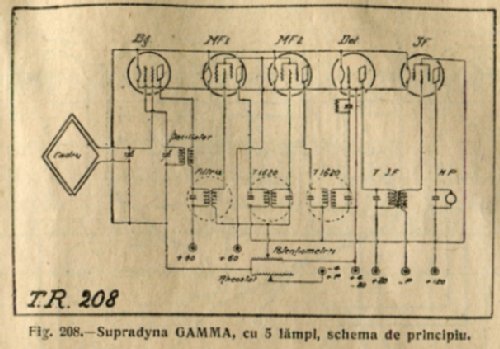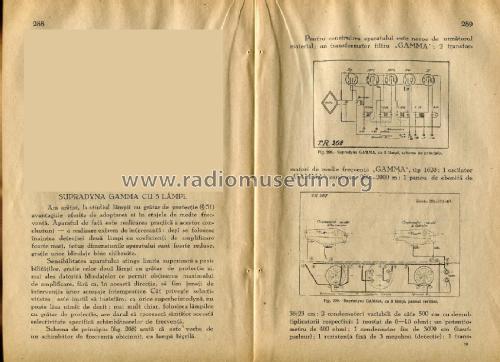Supradyne à 5 lampes
Gamma, Éts., Georges Gavoret & Cie; Paris, Izieux
- Pays
- France
- Fabricant / Marque
- Gamma, Éts., Georges Gavoret & Cie; Paris, Izieux
- Année
- 1930 ??
- Catégorie
- Boîte de construction (composants et manuel) ou instructions
- Radiomuseum.org ID
- 287376
Cliquez sur la vignette du schéma pour le demander en tant que document gratuit.
- No. de tubes
- 5
- Principe général
- Super hétérodyne (en général); FI/IF 55 kHz; 1 Etage(s) BF
- Circuits accordés
- 3 Circuits MA (AM)
- Gammes d'ondes
- PO et GO
- Tension / type courant
- Piles (rechargeables ou/et sèches) / 4 & 40 & 60 & 80 & 120 & negative bias Volt
- Haut-parleur
- - Ce modèle nécessite des HP externes
- Matière
- Matériaux divers
- De Radiomuseum.org
- Modèle: Supradyne à 5 lampes - Gamma, Éts., Georges Gavoret &
- Forme
- Chassis (pour intégration dans meuble)
- Dimensions (LHP)
- 360 x 230 x 105 mm / 14.2 x 9.1 x 4.1 inch
- Remarques
-
Instructions de montage / kit assembly instructions, "Supradyne Gamma à 5 lampes".
Publié par / published by Ing. I. C. FLOREA, "Toate Tainele Radiofoniei" ("Tous les Secrets de la Radiophonie" / "All the Secrets of Radiophony"), Bucharest 1930.
- Schémathèque (1)
- Ing. I. C. FLOREA "Toate Tainele Radiofoniei", p.288-290
- Auteur
- Modèle crée par Pitagora-Petru Schorsch. Voir les propositions de modification pour les contributeurs supplémentaires.
- D'autres Modèles
-
Vous pourrez trouver sous ce lien 18 modèles d'appareils, 15 avec des images et 2 avec des schémas.
Tous les appareils de Gamma, Éts., Georges Gavoret & Cie; Paris, Izieux
Collections
Le modèle Supradyne à 5 lampes fait partie des collections des membres suivants.
Contributions du forum pour ce modèle: Gamma, Éts., Georges: Supradyne à 5 lampes
Discussions: 1 | Publications: 1
HOW TO ASSEMBLE THE GAMMA “SUPRADYNE” WITH FIVE VALVES
The study of the screen grid valve (§51) emphasized the advantages to be gained by its employment in the intermediate frequency stages. The present set – a very interesting achievement - puts this in practice: Although using before detection two valves with a very high gain, the size of the set is very small, due to a carefully designed screening. The circuit diagram (fig. 208) shows a common frequency-mixer-receiver employing a two-grid valve (bigrille) in the first stage:

Fig.209 shows the wiring and components on the vertical panel:

Fig. 210 shows the same on the horizontal panel:

The set’s sensitivity reaches the upper limit, due to the employment of the two screen-grid valves as intermediate frequency amplifiers, and especially to the careful screening, allowing maximum amplification without the risk of self-oscillation. Also due to the employment of the screen grid valves, the high selectivity, common to every super-heterodyne, is here sensibly enhanced.
Following parts are needed to assembly the set:
1 "GAMMA" filter transformer.
2 "GAMMA" intermediate frequency transformers, type 1620.
1 "GAMMA" combined oscillator, 200 - 2000 m.
1 ebonite panel 36 × 23 cm.
2 slow-motion 500 cm variable capacitors.
1 rheostat 6 - 10 ohms.
1 potentiometer 400 ohms.
1 fix capacitor 3000 cm (loudspeaker).
1 resistor 3 Megohms (grid leak).
1 low frequency transformer ratio 1: 3.
Connection wire, screws, banana sockets power supply cord.
[The publicity section of the book contains at page 298 an advert from one of the main radio-parts supplier in Bucharest in those times: “RADIO-MATERIAL NICOLAE SARU” offering the complete set of components for the kit:]

The valves could be chosen from the following list:

*****
Pièces jointes
- GAMMA_SUPRADYNE5_HOR (251 KB)
- GAMMA_SUPRADYNE5_QUOTE (239 KB)
- GAMMA_SUPRADYNE5_VALVES (222 KB)
- GAMMA_Supradyne5_sch (210 KB)
- GAMMA_SUPRADYNE5_VERT (251 KB)
Pitagora-Petru Schorsch, 17.Jan.17


